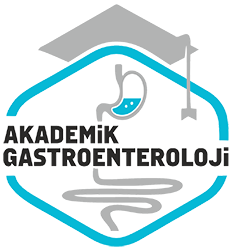Diffüz antral gastrit ve multifokal atrofik gastritli hastalarda mide sivisi askorbik asit düzeyleri ve epitel hücre proliferasyonlarinin karsilastirilmasi
Comparison of the patients with diffuse antral and multifocal atrophic gastritis for gastric juice ascorbic acid levels and epithelial cell proliferations
- Ana Sayfa
- Sayılar
- Diffüz antral gastrit ve multifokal atrofik gastritli hastalarda mide sivisi askorbik asit düzeyleri ve epitel hücre proliferasyonlarinin karsilasti...
Haseki Egitim ve Arastirma Hastanesi, Patoloji Bölümü2, , I. Iç Hastaliklari Klinigi4, , Istanbul
I.Ü. Istanbul Tip Fakültesi, Gastroenterohepatoloji Bilim Dali3, , Istanbul
Özet
Giris ve amaç: Diffüz antral gastrit (DAG), kronik Helicobacter pylori gastritinin duodenal ülser fenotipini, multifokal atrofik gastrit (MAG) ise gastrik kanser fenotipini olusturmaktadir. Bu çalismada DAG ve MAG’li olgularda gastrik sivi askorbik asit düzeylerinin incelenmesi, gruplarin mide epitel hücre proliferasyon oranlari açisindan karsilastirilmasi ve mide sivisi askorbik asit (C vitamini) düzeyleriyle hücre proliferasyon oranlari arasindaki olasi korelasyonlarin arastirilmasi amaçlanmi stir. Gereç ve yöntem: H. pylori’ye bagli 27 MAG, 10 DAG saptanan 37 hasta çalismaya alindi (22 kadin, 15 erkek, 19-74, yas ort: 43,6). Hastalari n plazma ve gastrik sivi örneklerinde askorbik asit düzeyleri ölçüldü. Olgularin antrum ve korpuslarinda hücre proliferasyonundan dolayi foveolar epiteldeki maturasyon kaybinin varligi, sitokeratin-20 (CK-20) antikoru kullanilarak immunohistokimyasal yöntemle gösterildi. Bulgular: Her iki grubun plazma askorbik asit düzeyleri arasinda anlamli farklilik yoktu. Gruplar, mide sivisi askorbik asit düzeyleri açisindan karsilastirildiginda istatistiksel anlamli bir farklilik gözlenmedi (DAG ve MAG için sirasiyla; 0.93±0.97, 0.96±1.12mg/dl, p>0.05) MAG grubunda CK-20 için boyanma yüzdesi DAG grubundakilere göre anlamli derecede düsüktü (%74.7 ve %90.9, p<0.01). Boyanma yüzdeleriyle mide sivisi askorbik asit degerleri arasinda bir korelasyon saptanmadi. Sonuç: Bu çalismada diffüz antral gastrit ve multifokal atrofik gastritli hastalar arasinda mide sivisi askorbik asit düzeyleri açisindan anlamli farklilik bulunmamistir. Ancak, multifokal atrofik gastritin intestinal tip gastrik karsinogenez sürecinin proksimal asamalarinda yer aldigini destekleyecek sekilde, bu gastrit formunda epitel hücre proliferasyonunun artmis oldugu gösterilmistir.
Abstract
Background/aim: Diffuse antral gastritis (DAG) is a duodenal ulcer phenotype of chronic Helicobacter pylori gastritis, while multifocal atrophic gastritis (MAG) is a gastric cancer phenotype. The aim of this study was to investigate ascorbic acid (vitamin C) levels in the gastric juice in patients with DAG and MAG, to compare the gastric epithelial cell proliferation rates between the groups and also to examine any correlation between ascorbic acid levels in gastric juice and the cell proliferation rates. Materials and methods: Thirty-seven patients with chronic H. pylori gastritis (27 MAG, 10 DAG) were included in the study (male/female: 15/22, range: 19-74, mean age: 43.6 yrs). Ascorbic acid concentrations in fasting plasma and gastric juice samples of the patients were measured. Loss of maturation in foveolar epithelium due to cell proliferation was shown immunohistochemically using cytokeratin-20 antibody in antral and corporal regions of both patient groups. Results: There was no significant difference in plasma ascorbic acid levels between the two groups. No statistically significant difference could be demonstrated in gastric juice ascorbic acid concentrations between patients with DAG and MAG (0.93±0.97 mg/dl and 0.96±1.12 mg/dl, respectively; p>0.05). Immunohistochemical examination revealed that staining for cytokeratin- 20 was significantly less in MAG patients than in those with DAG (74.7% vs 90.9%, respectively; p<0.01). There was no correlation between cytokeratin-20 staining and ascorbic acid concentrations in gastric juice. Conclusion: Ascorbic acid levels in gastric juice of DAG and MAG patients did not demonstrate a significant difference, but it has been shown that gastric epithelial cell proliferation is increased in MAG, supporting the hypothesis that this phenotype of gastritis is located on proximal steps of gastric carcinogenesis.



